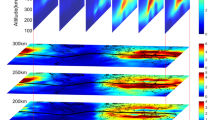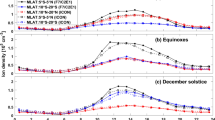Abstract
The ionospheric radiance and electron density observed by the tiny ionospheric photometer (TIP) and GPS occultation experiment (GOX) payloads on FORMOSAT-3/COSMIC satellites are applied to determine the boundaries of the auroral oval and its width in the winter nighttime ionosphere for both hemispheres. The TIP collects ionospheric emission at 135.6 nm due to electron impact excitation, while the GOX offers ionospheric electron density profiles with radio occultation (RO) technique. Comparison between them shows similar patterns of the plasma structure in the polar caps. The mean width of the auroral bands ranges between about 2 and 11° latitude in the winter nighttime and it varies with longitudes. The comparison by month suggests that the mean radius of the auroral ovals varies with the intensity of the auroral radiance.






Similar content being viewed by others

References
Anthes RA et al (2008) The COSMIC/FORMOSAT-3 mission: early results. Bull Am Meteorol Soc 89:313–333. doi:10.1175/BAMS-89-3-313
Budzien SA, Coker C, Dymond KF, Chua DH (2006) Tiny ionospheric photometer experiment aboard FORMOSAT-3/COSMIC. In: FORMOSAT-3/COSMIC Workshop 2006—early results and IOP campaigns, Taipei, Taiwan, 28 November–1 December 2006
Dymond KF, Nee JB, Thomas RJ (2000) The tiny ionospheric photometer: an instrument for measuring ionospheric gradients for the COSMIC constellation. Terr Atmos Ocean Sci 11:273–290
Dymond KF, Budzien SA, Chua DH, Coker C, Liu JY (2009) Tomographic reconstruction of the low-latitude nighttime electron density using FORMOSAT-3/COSMIC radio occultation and UV photometer data. Terr Atmos Ocean Sci 20:215–226. doi:10.3319/TAO.2008.01.15.01(F3C)
Kalmanson PC, Budzien SA, Dymond KF (2004) The tiny ionospheric photometer instrument design and operation. Proc SPIE 5660:259. doi:10.1117/12.578341
Kelley MC (1989) The Earth’s ionosphere: plasma physics and electrodynamics. Academic Press, San Diego
Lei J, Syndergaard S, Burns AG, Solomon SC, Wang W, Zeng Z, Roble RG, Wu Q, Kuo Y-H, Holt JM, Zhang S-R, Hysell DL, Rodrigues FS, Lin CH (2007) Comparison of COSMIC ionospheric measurements with ground-based observations and model predictions: preliminary results. J Geophys Res 112:A07308. doi:10.1029/2006JA012240
Syndergaard S, Schreiner WS, Rocken C, Hunt DC, Dymond KF (2006) Preparing for COSMIC: inversion and analysis of ionospheric data products. In: Foelsche U, Kirchengast G, Steiner AK (eds) Atmosphere and climate: studies by occultation methods. Springer, Berlin, pp 37–146
Wu BH, Chu V, Chen P, Ting T (2005) FORMOSAT-3/COSMIC science mission update. GPS Solut 9:111–121. doi:10.1007/s10291-005-0140-z
Acknowledgment
This work was supported by the National Space Organization in Taiwan grant 98-NSPO(B)-GE-GH01-03.
Author information
Authors and Affiliations
Corresponding author
Rights and permissions
About this article
Cite this article
Tsai, HF., Liu, JY., Lin, CH. et al. FORMOSAT-3/COSMIC observations of the ionospheric auroral oval development. GPS Solut 14, 91–97 (2010). https://doi.org/10.1007/s10291-009-0137-0
Received:
Accepted:
Published:
Issue Date:
DOI: https://doi.org/10.1007/s10291-009-0137-0



